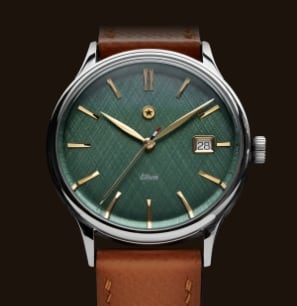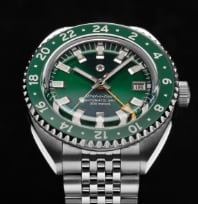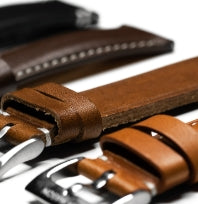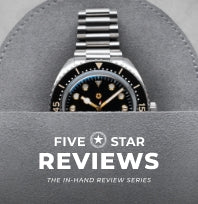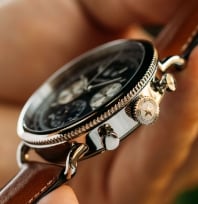It’s not the size that counts—it’s what you do with it: an adage as true for sports cars as it is for watches.
When it’s time to buy a watch, you may find yourself asking, “Is my wrist big enough?” or “Is my wrist too big?” First, we’d like to reassure you that, while there may be particular styles that work better for you than others, your wrist can’t be too big or too small for a watch. However, knowing what size wrist you have is necessary to understand what watch style will look best on you.
We are here to answer those questions for those wondering what the average wrist size is and how their own wrists measure up. We’re also going to teach you how to measure your wrist and give some tips on how to pick the right watch for your wrist size. Read on to learn about wrist size and how your newfound knowledge can help you find your next watch.
How To Measure Your Wrist
Before we address where your wrist fits on the size spectrum, let’s teach you how to measure your wrist. There are a couple of ways to do this—one requires a tape measure, and the other requires a ruler, a length of string, and a marker or pen.
While it doesn’t matter which wrist you wear your watch on, it does matter which one you measure—while your wrists are probably very similar in size, they can be slightly different, so you want to measure the wrist on which you’ll be wearing your watch.
Tape Measure
This is the easiest method, but it requires a tape measure. While you could potentially use the thin metal tape measure that you’d find in a toolbox, it’s definitely easier and more accurate to use the soft, flexible cloth type used by tailors.
- Place one end on your wrist and wrap the tape around.
- Read the measurement where the tape meets itself.
Ruler and String
If you don’t have a measuring tape, you can also use a regular ruler, a piece of string, and a marker or pen. Ideally, use a string that’s about a foot (or 30 cm) long—you don’t want it to be too long, but a bit of length will make this much easier.
- Wrap the string around your wrist, making sure that the string isn’t slack. If the string isn’t snugly around your wrist, your measurement won’t be accurate.
- Using the marker or pen, mark the string at the point where the end meets.
- With a ruler, measure the length of the string from the end to the marking (make sure you measure from the correct end!)
That’s it! Knowing the measurement of your wrist, you can now see where you fall compared to the average. Read on!
Wrist Sizes
Once you’ve measured your wrist, you can compare it to these general sizes and see how it measures up:
- 6-inch wrist or smaller – considered small
- 7-inch to just under 8-inch wrist – considered average
- 8-inch wrist and larger – considered large
How To Pick The Right Watch For Your Wrist
No matter what size your wrist is, never fear—there are plenty of watches that are perfect for you. You just need to know how to shop for your wrist size.
When it comes down to it, the best watch for you is the one that you feel comfortable wearing. Your watch should suit your individual style and boost your confidence.
That said, there are some things to keep in mind:
Watch Case Diameter
Watch cases come in a variety of sizes, and a tiny watch case might look a little out of place on a large wrist. On the other hand (pun intended), a large watch case might look enormous on a small wrist. Try and look for a watch case that’s proportional to your wrist. In general, a thicker wrist will look better with a larger watch case, and a thinner wrist will look better with a smaller one.
Watch Case Thickness
Just as the watch case’s diameter is an essential factor in buying the right watch for your wrist size, the thickness of the case can mean the difference between a proportional watch and one that sticks out—literally. If you have a thinner wrist, try a thinner watch case; if you have a thicker wrist, try a thicker one.
As for how watch cases measure up in the industry:
- 6mm-8mm – considered thin
- 8mm-12mm – considered average
- 14mm-18mm – considered thick
Watch Face Details and Complications
Any watch enthusiast will tell you that there are countless styles of watches—some with large features and multiple complications and some with basic, subtle qualities. While the style of your watch is up to you, a simpler, more classic field watch will have a slimmer, more streamlined look than a highly technical sports watch.
Remember: none of these rules are hard-and-fast, life-or-death need-to-dos. Feel free to go against them in favor of your own style—fashion’s a nebulous thing, and whether you’re able to pull off a style choice usually comes down to how confidently you wear it.
How To Measure Your Strap
If you have a watch band that you want to measure, keep these tips in mind for taking down the measurements—doing so can help you figure out if your existing watch is the right fit or if you need to take it in to have it resized.
- Measure from the inside edge of the buckle to the other end of the strap
- If it’s a 2-piece strap, measure both sides separately and add the measurements together
- If it’s a 1-piece strap, use the same process—measure the whole strap from the inside edge of the buckle to the other end of the strap
To know if a strap is going to fit your wrist, you have to measure the minimum and maximum length of your strap
- Minimum Length: measure from the inside edge of the buckle to the first hole in the strap
- Maximum Length: measure from the inside edge of the buckles to the last hole in the strap
How To Resize Your Watch
Many wristwatches have adjustable straps that are easy to fit to your wrist—straps made of leather, silicone, or fabric are usually pretty customizable.
However, watches with metal bands are a little more complicated when it comes to altering the fit. These metal straps are usually made to fit a specific wrist size. If your watch is too small or large for your wrist, don’t worry—you can always get it resized, or you can always get a new watch band if need be.
It’s possible to resize your watch on your own at home, but doing so requires a set of specialty tools that the average person probably doesn’t have in their toolbox—like special push pins (not the bulletin board kind) and a jewelry hammer. Check out our guide on how to alter your metal watch band if you’d prefer to tackle the task on your own.
If you don’t have jeweler’s tools and don’t want to have to purchase any, it’s much easier to bring your watch to a watch and jewelry repair shop and pay a professional to take care of the resizing for you.
Another option is to buy your watch from a watchmaker that makes it easy to change out the strap at a moment’s notice. All Jack Mason watch straps are easily interchangeable—from the more casual fabric and cork straps to our luxury leather straps.
It’s Not The Size…
Ultimately, the size of your wrist doesn’t matter much (unless you’re an Olympic volleyball player). Even when choosing the perfect watch for you, there is no rule that can’t be bent or broken. But just like in grammar and music theory, it’s important to know the rules first—so you can break them with intention.
If you have a small wrist and want to wear a bold, large watch, go right ahead; if you have a large wrist and prefer a slim and subtle timepiece, don’t let us stop you. The best watch for you is the watch that makes you look and feel your best when it comes down to it.
At Jack Mason, we believe that your watch should reflect your individual style while also lasting a lifetime. That’s why all of our watches come with a lifetime warranty. And with a host of options, from casual field watches to more formal dress watches, there’s something in our collection for every person in every situation. But don’t take our word for it; explore what we have to offer and see for yourself. We’re sure that Jack Mason has the right watch for you—no matter what size your wrist is.
Sources:
How to Measure Your Wrist to Get Your Body Frame Size | Live Strong
6 Essential Ways To Start Dressing With Confidence | Lifehack
Why It’s Necessary to Learn the Rules Before You Break Them | Lifehack
